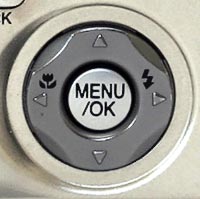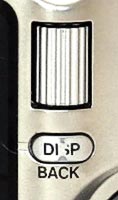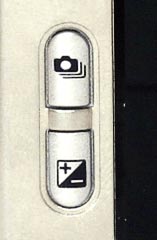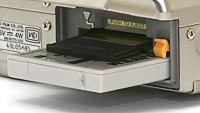Fujifilm Finepix F810
Review Date: March 30th 2005
|
Ease of Use
The Fujifilm Finepix F810 is a very stylish and well-built digital camera that has an elongated feel to it when you first pick it up, due to the 109mm width of the body which accommodates the wideangle 2.1 inch LCD screen. The camera is a little too wide to fit into the palm of my hand and feels much better when used two-handed rather than one. Also it won't easily fit into your shirt or trouser pocket - I wouldn't classify the the Fujifilm Finepix F810 as a pocketable camera. It is very well constructed, being built from a mixture of brushed aluminum and a few plastic parts. It certainly looks expensive and will no doubt impress your friends.
The Fujifilm Finepix F810 strikes the right balance in terms of the number of external controls on the camera. There are just enough to give you full control over the important aspects of the Fujifilm Finepix F810, but not so many that you're left wondering which one does what. The Fujifilm Finepix F810 instantly feels intuitive to hold and use. There's a traditional dial on the top of the camera that lets you select the different exposure modes; Auto, Program, Shutter Priority, Aperture Priority and Manual, and the various scene modes. This dial is a typical feature of SLR cameras, and enables you to quickly change between the various modes. It has a pleasing positive clicking action as you turn it.
There is a nice touch on the rear of the Fujifilm Finepix F810 in the form of a recessed area under the zoom buttons where your right thumb naturally sits. One aspect of the camera's controls that will take more time to get used to is the barrel which selects apertures and shutter speeds. Best controlled by your right thumb, this barrel is initially confusing simply because it is so unusual, but after a while it becomes second nature to set the aperture or shutter speed in this way. The other major controls on the Fujifilm Finepix F810, such as the shutter button, navigation pad and Off/Play/Camera switch all feel well made and responsive.
| Navigation Pad / Menu/OK Button / Macro/Left Button / Flash/Right Button | Exposure Mode Dial |
 |
 |
The only poorly designed aspects of the Fujifilm Finepix F810 are the tripod mount and USB connector, which are located next to each other on the bottom-right of the camera. I have no idea why the designers put the USB connector here, and the tripod mount should preferably be in the middle of the camera's base, especially when you consider that the F810 has such an elongated body. An equally unusual but much more effective design decision is the C-AF button, which sits on the front of the Fujifilm Finepix F810 next to the lens. This is initially so strange that you may not notice it for a while! It does actually make sense, however, as you can easily use your left forefinger to operate it and lock the focus on whatever is in the centre of the frame.
One of the most immediate and striking things about the Fujifilm FinePix F810 is the large LCD screen that dominates the back of the camera. The screen is a widescreen format 2.1 inch colour TFT LCD monitor with 174,000 pixels and 100% scene coverage, which makes composing pictures and movies in either the Standard or Widescreen format very easy. The large LCD is a little difficult to use in bright sunlight, but you can always use the small optical viewfinder instead (although it is a bit dim).
Like virtually all digital cameras the Fujifilm FinePix F810 has a Menu button on the rear of the camera which, as you would expect, gives you access to the software menu system. This lets you set various parameters including focusing, sharpness and white balance. As with most other Fujifilm digital cameras, there is also a blue F button (the Photo Mode button) which is positioned above and to the right of the LCD screen. Pressing this button opens the Photo Mode menu, which allows you to set the file quality, ISO speed and colour settings (B&W, Chrome or Standard). I'm not really sure why these 3 settings alone should fall under the heading of Photo Mode, and things like white balance and sharpening are just part of the standard menu. And I'm undecided about whether it is a good idea or not. The F button does give quick access to certain features, but you do have to memorise what another button does.
| Scroll Barrel / Display/Back Button | Continuous Shooting Button / Exposure Compensation Button |
 |
 |
The main menu system on the Fujifilm FinePix F810 is as well designed as previous Fujfilm digicams that I have reviewed. There is a horizontal row of icons along the bottom of the screen, which when selected reveal the options for that particular function, which you then access by scrolling up and down. Very easy to see and access. In addition to the Photo Mode button mentioned above, there are a few other features that you won't find in the main menu. The macro and flash functions are accessed by pressing the left and right arrows on the arrow pad, whilst the continuo's shooting and exposure compensation functions have their own dedicated buttons to the left of the LD screen.
The start-up time of the Fujifilm FinePix F810 , from turning the camera on to being ready to take a photo, is very quick at less than 0.50 second - very impressive. Equally speedy is the 4x zoom lens which only takes around 0.50 seconds to zoom from the widest focal length to the longest. The zooming mechanism is a little on the noisy side, but not so noticeable that you will attract unwanted attention. Focusing, confirmed by a green LED next to the optical viewfinder, is very quick in good light and also as good indoors or in low-light situations thanks to the powerful auto-focus assist lamp. The LCD screen is bright and clear and the refresh rate is fine, although it can be difficult to use in bright sunlight. Storing an image is fairly quick at around 0.75 seconds. The F810 has a number of continuous shooting and focusing modes which makes it well suited for fast moving subjects. All in all the Fujifilm Finepix F810 is one of the most responsive compact digital cameras in terms of its general operational speed that I have reviewed, in good or bad lighting conditions.
| Standard/Wide Mode Button / Photo Mode Button | Battery Compartment |
 |
|
Once you have captured a photo, the Fujifilm Finepix F810 has an above average range of options for playing, reviewing and managing your images. You can scroll through the images that you have taken, view thumbnails, play slideshows with various effects, and zoom in and out of the image. You can also add an audio clip to each image, delete an image, trim an image, lock images so that they cannot be deleted, and set various printing options. There is also a very useful histogram feature, accessed by holding down the Exposure Compensation button, which is a great help in evaluating the exposure of each image.
Overall the Fujifilm FinePix F810 is a very stylish and well-built digital camera that impresses with it's fast operation, large LCD screen and intuitive design. It may not be the most pocketable compact digicam, but it is one of the quickest and easiest to use.
|
 PhotographyBLOG is a member of the DIWA organisation. Our test results for the Fujifilm FinePix F810 have been submitted to DIWA for comparison with test results for different samples of the same camera model supplied by other DIWA member sites.
PhotographyBLOG is a member of the DIWA organisation. Our test results for the Fujifilm FinePix F810 have been submitted to DIWA for comparison with test results for different samples of the same camera model supplied by other DIWA member sites.
